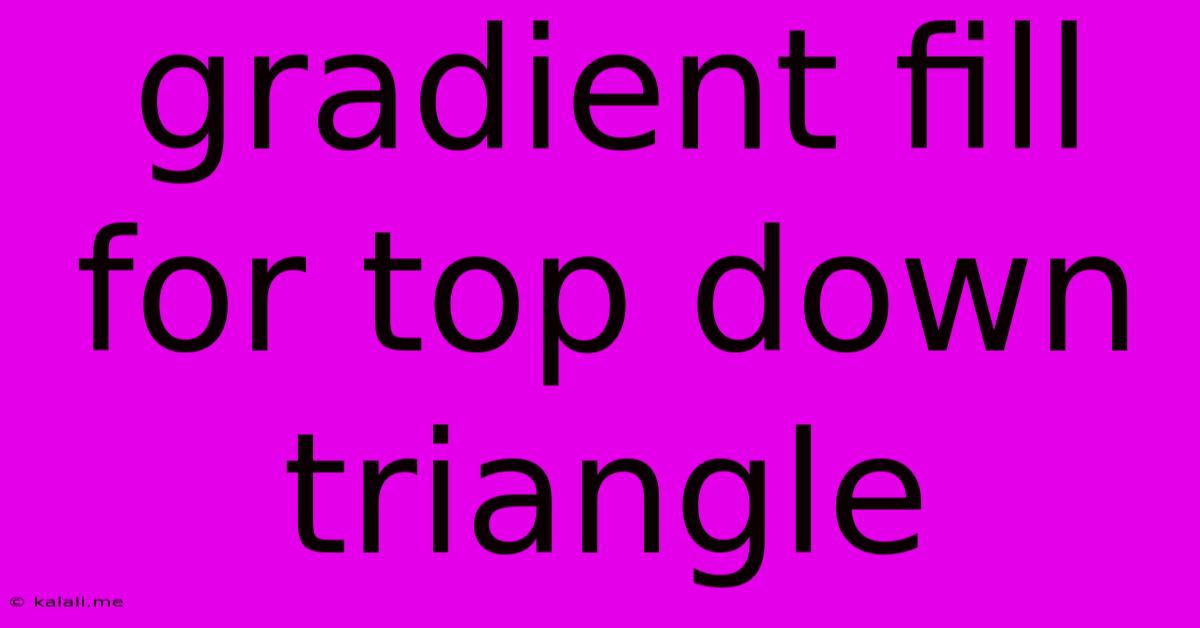Gradient Fill For Top Down Triangle
Kalali
Jun 03, 2025 · 3 min read

Table of Contents
Creating a Gradient Fill for a Top-Down Triangle
This article will guide you through the process of creating a gradient fill for a top-down pointing triangle, a common shape in graphic design and various applications. We'll explore different methods, from simple linear gradients to more complex radial and other gradient types, and discuss considerations for achieving the best visual results. This guide is useful for beginners and intermediate users alike, regardless of your chosen software.
Understanding Gradients
A gradient is a smooth transition between two or more colors. This creates a visual effect of depth, dimension, and can significantly enhance the overall aesthetic appeal of your design. Different types of gradients exist, each offering unique visual possibilities:
- Linear Gradient: A simple transition between colors along a straight line. This is the most common type and often suitable for filling simple shapes like triangles.
- Radial Gradient: Colors transition from a central point outwards, creating a more circular or radiating effect.
- Angular Gradient: Colors transition along an angle, often used for creating specific directional highlights or shadows.
- Mesh Gradient: Offers the most control, allowing for complex color transitions and blending. This is more advanced but provides unparalleled flexibility.
Methods for Applying a Gradient Fill to a Top-Down Triangle
The specific steps will vary depending on your software (Adobe Illustrator, Photoshop, GIMP, etc.), but the underlying principles remain consistent. Here's a general approach:
1. Create the Triangle:
Begin by creating a triangle pointing downwards. Most graphic design software offers tools for creating perfect geometric shapes. Use the polygon tool or similar functionality to define your triangle's vertices and size.
2. Select the Triangle:
Ensure your triangle is selected. This will be the shape you apply the gradient to.
3. Access the Gradient Tool:
Locate the gradient tool or panel within your software. This typically appears as a gradient icon or a panel labeled “Gradient,” “Fill,” or something similar.
4. Choose a Gradient Type:
Select the desired gradient type (linear, radial, etc.). For a top-down triangle, a linear gradient is often the most straightforward choice.
5. Adjust Gradient Settings:
This is where you customize the appearance of your gradient. You can adjust the following:
- Colors: Select the starting and ending colors of your gradient. Experiment with different color combinations to achieve the desired effect. Consider using complementary or analogous color schemes for harmonious results.
- Angle/Direction: For linear gradients, adjust the angle to control the direction of the color transition. A vertical linear gradient works well for a top-down triangle, aligning with the shape's orientation.
- Midpoint/Stops: You can add more color stops to create a more complex gradient with multiple color transitions. This allows for more nuanced shading and highlights.
- Gradient Type (Radial, Angular, Mesh): If you opt for a more complex gradient type, explore its settings to fine-tune the transition and blending.
6. Apply the Gradient:
Once you've configured your gradient settings, apply it to the selected triangle. The method for this will vary based on your software but typically involves clicking and dragging the gradient across the triangle shape or selecting the gradient from a fill menu.
Example Using Linear Gradient:
For a simple linear gradient, you'd likely select a vertical linear gradient, with a lighter color at the top vertex and a darker color at the base vertices of the triangle. This creates a natural shading effect, suggesting depth and volume.
Optimizing for Visual Appeal:
Experiment with different color combinations and gradient types to find the optimal look for your design. Consider the overall context of your project and ensure the gradient complements the other elements. High contrast can be impactful, while subtle gradients can be more understated and elegant.
By following these steps and experimenting with different settings, you can effectively create a gradient fill for your top-down triangle, adding visual richness and depth to your design. Remember to save your work frequently to avoid losing your progress.
Latest Posts
Latest Posts
-
Mary Mother Of Jesus Family Tree
Jun 05, 2025
-
Can You Sell A Leased Car
Jun 05, 2025
-
Will They Ever Add Another Mana Type Mtg
Jun 05, 2025
-
You Had Me At Hello Meaning
Jun 05, 2025
-
Mac Mini Should I Turn It Off Or Leave It
Jun 05, 2025
Related Post
Thank you for visiting our website which covers about Gradient Fill For Top Down Triangle . We hope the information provided has been useful to you. Feel free to contact us if you have any questions or need further assistance. See you next time and don't miss to bookmark.